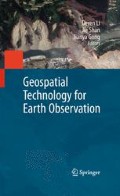Abstract
As remote sensing technologies have become ever more powerful due to the introduction of multi-platforms and multi-sensors, hundreds of terabytes of image data can be made available daily. But in many cases, raw remotely sensed images are not directly useful without further processing. There are more and more needs to aggregate remotely sensed image processing to satisfy the increasing demands of various applications. Remotely sensed image processing services are modular components that are self-contained, self-describing and can be published, located, and invoked across a network to access and process remote sensing data (Onchaga 2004). Remotely sensed image processing services encapsulate all processing functions into services and combine them into a service chain to provide a valueadded service. The various requirements of users can be achieved by combining different existing data and services into a value-added service chain.
Access this chapter
Tax calculation will be finalised at checkout
Purchases are for personal use only
Preview
Unable to display preview. Download preview PDF.
References
Alonso G, Casati F, Kuno Het al (2004) Web Services - Concepts, Architectures and Applications. Springer, Heidelberg
Canfora G, Penta M Di, Esposito R et al (2005) An approach for QoS-aware service composition based on genetic algorithms. Proceedings of the 2005 conference on Genetic and evolutionary computation
Cardoso J, Sheth A, Miller J et al (2004) Quality of service for workflows and Web service processes. J. Web Semantics 13: 281-308
Dadam P, Reichert M, Kuhn K (2000) Clinical Workflows–The Killer Application for Process-oriented Information Systems? 4th Int’l Conf. on Business Information Systems
Damen Z, Derks W (2000) Business-to-business E-Commerce in a Logistics Domain. The CAiSE*00 Workshop on Infrastructures for Dynamic Business-to-Business Service Outsourcing
Eder J, Panagos E, Rabinovich M (1999) Time constraints in workflow systems. Proceedings of the 11th International Conference
Gillmann M, Weikum G (2000) Performance and Availability Assessment for the Configuration of Distributed Workflow Management Systems. International Conference on Extending Database Technology
Gillmann M, Weikum G, Wonner W (2002) Workflow management with service quality guarantees. Proceedings of ACM SIGMOD International Conference on Management of Data
Grefen P (2000) CrossFlow: Cross-organizational Workflow Management in Dynamic Virtual Enterprises. International Journal of Computer Systems Science & Engineering, 15(5): 277–290
Hwang S, Wang H, Tang J et al. (2007) A probabilistic approach to modeling and estimating the QoS of web services-based workflows. Int. J. Inf. Sci. 177: 5484-5503
Klingemann J, Wäsch J (1999) Deriving Service Models in Cross-Organizational Workflows. Proceedings of RIDE - Information Technology for Virtual Enterprises
Marjanovic O (2000) Dynamic Verification of Temporal Constraints in Production Workflows. Proceedings of the 11th Australian Database Conference
Menasce D (2004) Response-time analysis of composite Web services. IEEE Internet Comput. 8(1):90–92
Onchaga R (2004) Modelling for quality of services in distributed geoprocessing. 20th Congress of the ISPRS
Onchaga R (2006). Quality of service management framework for dynamic chaining of geographic information services. Int. J. Appl. Earth Obs. Geoinf. 2006(8): 137-148
Onchaga R, Morales J, Lambert J (2008). An ontology framework for quality of geographical information services. Proceedings of the 16th ACM SIGSPATIAL international conference on Advances in geographic information systems
Philipose S (1986) Operations Research - A Practical Approach. Tata McGraw-Hill, New York
Pozewaunig H, Eder J (1997) ePERT: Extending PERT for workflow management systems. First European Symposium in Advances in Databases and Information Systems
Zeng L, Benatallah B, Ngu A et al (2004) QoS-aware middleware for Web services composition IEEE Trans. Software Eng. 30(5):311–327
Author information
Authors and Affiliations
Editor information
Editors and Affiliations
Rights and permissions
Copyright information
© 2010 Springer Science+Business Media, LLC
About this chapter
Cite this chapter
Zhu, Q., Yang, X., Li, H. (2010). Optimal Composition Algorithm Concerned with Response Time for Remotely Sensed Image Processing Services. In: Li, D., Shan, J., Gong, J. (eds) Geospatial Technology for Earth Observation. Springer, Boston, MA. https://doi.org/10.1007/978-1-4419-0050-0_14
Download citation
DOI: https://doi.org/10.1007/978-1-4419-0050-0_14
Published:
Publisher Name: Springer, Boston, MA
Print ISBN: 978-1-4419-0049-4
Online ISBN: 978-1-4419-0050-0
eBook Packages: Earth and Environmental ScienceEarth and Environmental Science (R0)

